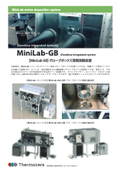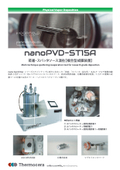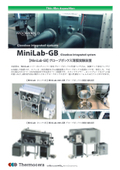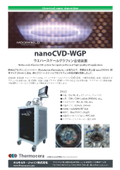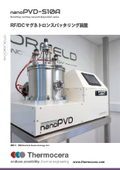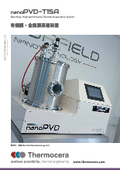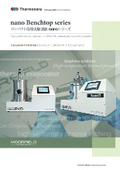MiniLab Series Flexible Thin Film Experiment Device
Due to its modular embedded design, it is possible to flexibly assemble dedicated equipment according to the required film formation method. A compact thin-film experimental device that can accommodate various research applications.
**Flexible System** The MiniLab thin film experimental device series allows for easy construction of a compact device configuration without waste, even as a customized product, by incorporating suitable components (such as deposition sources and stages) and control modules according to the required deposition methods and materials from a wide range of options. By configuring the device with a modular control unit in a Plug&Play manner, the application range expands, enabling various thin film process experiments. The MiniLab series is a high cost-performance system that caters to a wide range of applications from research and development to small-scale production. **Small Footprint & Space Saving** - Single Rack Type (MiniLab-026): 590(W) x 590(D)mm - Dual Rack Type (MiniLab-060): 1200(W) x 590(D)mm - Triple Rack Type (MiniLab-125): 1770(W) x 755(D)mm **Excellent Operability & Intuitive Operation Screen** Windows PC or 7” touch panel. Easy operation that does not require advanced skills, while ensuring maximum safety.
basic information
【MiniLab Flexible Thin Film Experimental Device Configuration Modules】 ◉ Manufacturing Range Resistance Heating Deposition (TE), Organic Film Deposition (LTE), Electron Beam Deposition (EB), RF/DC Sputtering (SP), T-CVD/PE-CVD, Plasma Etching (RIE) ◉ Chambers ・026 (26 Liters) - TE/LTE/SP/CVD/Etch/*Globe Box option: Max Φ6 inch ・060 (60 Liters) - TE/LTE/EB/SP/Etch/: Max Φ8 inch ・080 (80 Liters) - TE/LTE/EB/SP/Etch/: Max Φ10 inch ・090 (90 Liters) *Globe Box option - TE/LTE/EB/SP/Etch/: Max Φ10 inch ・125 (125 Liters) - TE/LTE/EB/SP/Etch/CVD: Max Φ12 inch * For other specifications, please refer to our website.
Price information
Please feel free to contact us.
Delivery Time
Applications/Examples of results
Main uses: - Development of new materials - Advanced technology development - Small-scale prototype production and so on.
Detailed information
-

MiniLab-026-TE/LTE/SP The smallest model in the MiniLab series, a standalone thin film experimental device with a 19-inch single rack frame. It has a compact size requiring a minimum installation space of 600mm in width and 600mm in depth, allowing for TE (resistive heating evaporation), LTE (organic thin film evaporation), and SP (sputtering) experiments. Despite its small size, it features PID automatic loop film deposition control (manual operation is also possible) and simultaneous deposition capabilities.
-

MiniLab-026-GB (Glove Box Storage Type) A glove box model with the MiniLab-026 chamber installed in the workbench and the control unit stored underneath the bench.
-

MiniLab-026 Etch/Anneal Station A device equipped with an RF dry etching stage and a substrate heating stage in the MiniLab-026 chamber. It comes in two models: a standalone version housed in a MiniLab series 19-inch rack frame and a glovebox version called MiniLab-026-GB. This product is a collaborative development with the University of Manchester's graphene group. It contributes to TMDC and 2D development through a unique RIE system with low damage and excellent control precision at under 30W.
-

MiniLab-060-TE/LTE/EB/Sputtering Device The "MiniLab-060" series is an R&D device that can be configured for a wide range of purposes, including TE (resistive heating evaporation), LTE (low-temperature organic film deposition), EB evaporation, and RF/DC magnetron sputtering, by modularly incorporating a rich variety of components. There are also many options available, such as vertical lift, substrate rotation, heating and cooling stages, and load locks. (The photo shows the EB model equipped with a 6 pockets evaporation source.)
-

The MiniLab-060 PECVD device is a semi-automatic plasma CVD machine equipped with up to four gas lines, RF/DC power units, and a substrate heating and rotating stage (max 1200°C). It features a high vacuum specification with a 60L volume chamber, equipped with RP (DP) + TMP, allowing for stable automatic control of vacuum and gas pressure through PLC/MFC. It is capable of conducting film formation experiments for wafer sizes ranging from 1 to 8 inches.
-

MiniLab-080-TE/LTE/SP Box-type chamber: A higher model than the MiniLab-060, which can add a load lock mechanism to an 80-liter large chamber with a chamber height of 570mm. The long adjustment range of the T/S distance contributes to improved film uniformity.
-

MiniLab-090 (*Glove Box Storage Type) This is a glove box model of the Mini-Lab-080, which features a large 80L chamber (400x400x570) stored within the workbench. It has a front-loading design with sliding doors, a maintenance door accessible from the back of the chamber, and is a space-saving, high-spec model that maximizes the use of the workbench despite its large chamber. It can be used for various purposes such as vacuum deposition, sputtering, and RF etching. It allows for clean thin film experiments without exposing samples to the atmosphere or moisture after processing.
-

MiniLab-125 All options of the MiniLab series can be equipped in a large high-capacity chamber (500x500x600mm). It is the top flagship model of the MiniLab series, covering applications from research and development to small-scale production. It offers a wide range of options such as a load lock system, automatic mask changer, and planetary dome.
Related Videos
catalog(37)
Download All Catalogs
News about this product(60)
-

◇◆◇ nanoPVD-S10A Magnetron Sputtering Device ◇◆◇
This is a research and development RF/DC magnetron sputtering device. Despite its high performance and multifunctionality, it fits into limited laboratory space with a compact size and easy operation via a 7-inch front touch panel. ● Achievable pressure: 5x10^-5 Pa (*fastest 30 minutes to 1x10^-4 Pa!) ● Film uniformity: ±3% ● Various options: up/down rotation, heater, cathode for magnetic materials, and more ● 3-source cathode + 3 MFC systems, with additional RF/DC power supply, allowing for versatile applications such as multilayer films and simultaneous deposition. - Insulating films - Conductive films - Compounds, etc. 【Main Features】 ◉ Compatible substrates: 2" (up to 3 sources) or 1" (1 source) ◉ 2" cathode x up to 3 sources ◉ Easy operation via touch panel with PLC automatic program control ◉ High-precision APC process control with MFC ◉ Up to 3 MFC systems ◉ USB port for Windows PC connection, capable of creating and saving recipes for up to 1000 layers and 50 films. Live data logging on PC. ◉ Vacuum system: TMP + RP (*dry pump option) ◉ Substrate rotation, vertical lift, and heating (Max 500℃) ◉ Quartz crystal film thickness monitor/controller
-

Wafer Annealing Equipment [ANNEAL] Max 1000℃ APC Automatic Pressure Control MFC x3 System Compatible with Φ4 to 6 inch Substrates
Max 1000℃, MFC up to 3 systems, APC pressure control, compatible with substrates from 4" to a maximum of 6", high vacuum annealing device (<5 × 10-7 mbar) [ANNEAL] is a research and development annealing device capable of high-temperature heat treatment of substrates such as wafers in a stable process atmosphere. It allows high-temperature processing up to 1000℃ using a heating stage installed in a high vacuum water-cooled SUS chamber. A heat shield is installed inside the chamber to ensure safety through interlock. The mass flow controller can be expanded to a maximum of 3 systems, enabling firing operations with precisely adjusted process gas pressure (APC automatic process control system option). Additionally, there are many options available, including a front view port, dry scroll pump, special substrate holder, and additional thermocouples. The heating stage inside the chamber has three variations depending on the process gas atmosphere and treatment temperature: - Halogen lamp heater: Max 500℃ - C/C composite heater: Max 1000℃ (in vacuum, inert gas only) - SiC coating heater: Max 1000℃ (vacuum, inert gas, O2)
-

☆★☆【nanoETCH】Soft Etching Device☆★☆
<30W Low Power Control for Damage-Free Etching Achieves delicate etching processes with an output control precision of 10mW. A jointly developed product with the graphene research group at the University of Manchester, led by Nobel Prize winners who discovered graphene in 2010. 【Features】 • 2D (Transition Metal Chalcogenides, graphene delamination after material transfer): Surface modification cleaning • Removal of polymer resists such as PMMA and PPA • Surface modification and etching on substrates prone to damage, such as Teflon substrates • h-BN sidewall etching (*Option for "Fluorine Gas Supply Module," requires SF6 gas system) • SiO2 etching (*Option for "Fluorine Gas Supply Module," requires CHF3 gas system) 【Specifications】 ◉ Compatible substrates: Up to Φ6 inches ◉ Easy operation with a 7" touch panel and PLC automatic sequencing ◉ Automatic pressure control (APC) ◉ One Ar gas line (standard) + up to three additional lines for N2 and O2 ◉ Connects to a Windows PC with a USB port for automatic etching recipe creation and storage. Data logging on PC.
-

◆◇◆【nanoCVD-8G】 Graphene Synthesis Device ◆◇◆
◉ High-efficiency and high-precision process control using cold wall method ◉ Rapid heating: 1100℃ in approximately 3 minutes ◉ High-precision temperature control: ±1℃ ◉ High-precision APC automatic pressure control system: 3 gas lines (Ar, H2, CH4) ◉ Standard recipe for graphene production included ◉ Compact size: 405(W) x 415(D) x 280(H) mm ◆Features◆ - Easy operation! Operation and recipe management via 5-inch touch panel - Up to 30 recipes and 30-step program creation possible - PC software included for USB cable connection, offline recipe creation on PC → upload/download to device, CSV data output - Maximum sample size: 40 x 40 mm: Copper (nickel) foil, SiO2/Si, Al2O3/Si substrates, etc. ◆Model: nanoCVD-8G◆ - Standard program for graphene included - High vacuum process, high-precision process pressure control - Rotary pump included as standard - 3 gas supply lines (Ar, H2, CH4) - Sample heating stage (high-purity graphite) Max 1100℃ - K-type thermocouple
-

◉Mini-BENCH-prism Semi-Automatic Ultra-High Temperature Experimental Furnace Max 2000℃
◉ Maximum operating temperature Max 2000℃ ◉ PLC semi-automatic control A higher model of the tabletop Mini-BENCH with semi-automatic control Automatically controls each process of "vacuum/purge cycle," "gas replacement," and "venting" Maximum operating temperature 2000℃ Semi-automatic control ultra-high temperature experimental furnace (carbon furnace, tungsten metal furnace) Compact and space-saving experimental furnace ◉ Effective heating range (crucible dimensions) - Planar heater heating range: Φ2 inch to Φ6 inch - Cylindrical heater heating range: Φ30 to Φ80 x Depth Max 100(H) mm ◉ Up to 3 MFC systems for automatic flow control (or manual adjustment) ◉ APC automatic pressure control ◉ Ensures safety during operation Monitors abnormal cooling water, chamber temperature, and overpressure. Made of SUS, the robust water-cooled chamber can be safely used even during continuous operation at maximum temperature. ◉ Compact and space-saving Width 603 x Depth 603 x Height 1,160 mm (*Installed inside rotary pump housing) Various sample heating experiments, such as ultra-high temperature heating of small samples and new material research and development, can be easily performed with simple operations. The main unit is compact yet can be used for research and development in various fields.
Recommended products
Distributors
【Endless possibility_thermal engineering...】 Our company sells vacuum thin film devices for semiconductor and electronic device fundamental research, ultra-high temperature heaters for CVD substrate heating, experimental furnaces, temperature measurement equipment, and more. To meet the endless demand for "heat," which is indispensable in any era, and to respond to various requests in the field of fundamental technology development, we aim to introduce the latest equipment and contribute to research and development in Japan.















